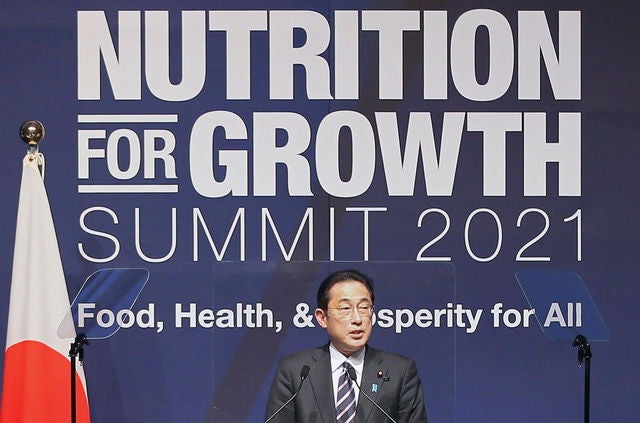Nutrition for Growth Summit nets $27bn in pledges to combat undernutrition
Undernutrition is one of the underlying causes of nearly half of under-five child deaths and the pandemic has only made things worse. New funding pledges from governments and NGOs at the Tokyo summit may make a big difference.

A cumulative US$27 billion pledge was made at the Nutrition for Growth (N4G) Summit in Tokyo, with the funds accompanying government and private sector donor commitments to renew policy and prioritize nutrition, particularly during the COVID-19 pandemic.
“Now is the time for us to take action,” said Japan’s Prime Minister Fumio Kishida, whose country committed US$2.8 billion to provide nutrition-related assistance globally. Ending hunger, achieving food security, improving nutrition, and promoting sustainable agriculture were top priorities, he said at the December 7-8 meeting, adding that the pandemic will likely cause 13.6 million more children to suffer from wasting.
According to Nutrition for Growth, malnutrition triggered by COVID-19 could result in the deaths of 283,000 children and leave 3.6 million more stunted over the next three years.
Undernutrition is one of the underlying causes of nearly half of deaths of children under five, but among the most underfunded – less than one percent of global foreign aid is currently spent on nutrition. For children who do survive malnutrition, the long-term effects can be devastating, affecting their overall physical and cognitive potential well beyond formative years. Compared to a healthy child, a stunted child is also more likely to have poorer educational outcomes, earn lower wages, and eventually have children who are themselves poorly nourished. For the global economy the price tag is also high, with the estimated impact of malnutrition being nearly [U$3.5 trillion per year](https://www.worldbank.org/en/research/brief/policy-research-note-no5-the-economic-costs-of-stunting-and-how-to-reduce-them).
The backdrop can seem stark. Nearly 22 percent of children under five are classified as stunted and the UN has stated that “the world is not on track to achieve Zero Hunger by 2030. If recent trends continue, the number of people affected by hunger would surpass 840 million by 2030.”
All this is why global leaders recommitted at the N4G Summit to ending hunger and 45 countries with high burdens of malnutrition promised to increase domestic programming and policies to address the issue.
Bangladesh, for example, committed to cutting anemia rates by one-third, stunting among children by one-fifth, and wasting among children by one-quarter within the next five years. Indonesia committed to fighting malnutrition via maternal and child nutrition interventions, including nutritional supplementation for adolescents and pregnant women, and nutrition care and support for children with severe malnutrition.
But there is also reason for optimism. Nutrition for Growth says global nutrition donors have all largely delivered on their previous Nutrition for Growth financial commitments, some several years early. According to the 2018 Global Nutrition Report, 10 of the 2013 signatories pledged a collective US$19.6 billion by 2020. The same 10 donors – the United States, European Union, United Kingdom, the Bill & Melinda Gates Foundation, Children’s Investment Fund Foundation, World Bank, Netherlands, Ireland, Germany, and Australia – cumulatively disbursed US$21.8 billion ahead of the 2020 goal.
Additionally, several LMICs have developed and enforced policies and practices that have slashed their stunting rates. Ethiopia, for example, cut its stunting rate from 67 to 39 percent between 1992 (when it was one of the poorest countries in the world) and 2016. Peru also saw stunting decline from almost two million to 370,000, from 2008 to 2016. And from 1997 to 2014, the Kyrgyz Republic halved its stunting rate.
The summit, which culminated the Nutrition for Growth Year of Action, a global effort to bring together country governments, donors, UN agencies, and corporations to accelerate progress on malnutrition. For their part, more than a dozen companies joined in the pledge to improve the nutritional quality of their products, contribute to more sustainable food systems, and improve the quality of their employees’ diets.
The next Nutrition for Growth Summit is scheduled to take in Paris in 2024 and some of the key issues ahead of that meeting are expected to be integrating nutrition into universal health coverage, promoting healthy diets and building sustainable food systems, addressing malnutrition effectively in fragile and conflict-affected contexts, promoting data-driven accountability, and mobilizing new investments in nutrition financing.
